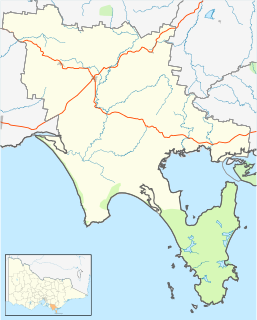
Jumbunna is a town in South Gippsland, Victoria, Australia. The name is taken from the eastern Kulin language of the Bunnerong tribe and means "a place to meet and talk".
Australian labour law concerns Commonwealth, state, and common law on rights and duties of workers, unions and employers in Australia. Australian labour law, has a dual structure, where some employment issues and relationships are governed by Commonwealth laws, and others are governed by state laws or the common law. It shares a heritage with laws across the Commonwealth of Nations, UK labour law and standards set by the International Labour Organization, the Australian legislature and courts have a built a comprehensive charter of rights at work.
Section 51 of the Constitution of Australia grants legislative powers to the Australian (Commonwealth) Parliament only when subject to the constitution. When the six Australian colonies joined together in Federation in 1901, they became the original States and ceded some of their powers to the new Commonwealth Parliament. There are 39 subsections to section 51, each of which describes a "head of power" under which the Parliament has the power to make laws.
The 1913 Australian Referendum was held on 31 May 1913. It contained six referendum questions and was held in conjunction with the 1913 federal election.

Amalgamated Society of Engineers v Adelaide Steamship Co Ltd, commonly known as the Engineers case, was a landmark decision by the High Court of Australia on 31 August 1920. The immediate issue concerned the Commonwealth's power under s51(xxxv) of the Constitution but the Court did not confine itself to that question, using the opportunity to roam broadly over constitutional interpretation.

R v Kirby; Ex parte Boilermakers' Society of Australia, known as the Boilermakers' Case, was a 1956 decision of the High Court of Australia which considered the powers of the Commonwealth Court of Conciliation and Arbitration to punish the Boilermakers' Society of Australia, a union which had disobeyed the orders of that court in relation to an industrial dispute between boilermakers and their employer body, the Metal Trades Employers' Association.
The reserved powers doctrine was a principle used by the inaugural High Court of Australia in the interpretation of the Constitution of Australia, that emphasised the context of the Constitution, drawing on principles of federalism, what the Court saw as the compact between the newly formed Commonwealth and the former colonies, particularly the compromises that informed the text of the constitution. The doctrine involved a restrictive approach to the interpretation of the specific powers of the Federal Parliament to preserve the powers that were intended to be left to the States. The doctrine was challenged by the new appointments to the Court in 1906 and was ultimately abandoned by the High Court in 1920 in the Engineers' Case, replaced by an approach to interpretation that emphasised the text rather than the context of the Constitution.

New South Wales v Commonwealth is a landmark decision of the High Court of Australia, which held that the federal government's WorkChoices legislation was a valid exercise of constitutional power. In essence, the majority found the Constitution's corporations power capable of sustaining the legislative framework, while the conciliation and arbitration and territories powers were also seen as supporting parts of the law. Further, the majority also held that the legislation permissibly limited State powers and did not interfere with State constitutions or functioning. A minority dissented.

R v Barger is a High Court of Australia case where the majority held that the taxation power could not be used by the Australian Parliament to indirectly regulate the working conditions of workers. In this case, an excise tariff was imposed on manufacturers, with an exemption being available for those who paid "fair and reasonable" wages to their employees.

Nationwide News Pty Ltd v Wills is a High Court of Australia case that deals with a number of issues regarding the Australian Constitution, including the Express right free interstate trade and commerce, the implied freedom of political communication, and the role of proportionality.
Common rule awards are a particular form of industrial award used in Australia to regulate minimum terms and conditions of employment. Awards are the end product of the processes of conciliation and arbitration where an industrial tribunal makes an award in settlement of an industrial dispute. Whereas awards are legally binding on all parties to the dispute which are named in the award, with common rule awards all employers in the industry or occupation covered by the award are bound by it.

New South Wales v Commonwealth, commonly known as the Wheat case, or more recently as the Inter-State Commission case, is a landmark Australian judgment of the High Court made in 1915 regarding judicial separation of power. It was also a leading case on the freedom of interstate trade and commerce that is guaranteed by section 92 of the Constitution.

Attorney-General (NSW) v Brewery Employees Union of NSW, commonly known as the Union Label case, was a landmark decision by the High Court of Australia on 8 August 1908. The case was significant in relation to the endorsement by the majority of the court of the reserved powers doctrine and as the first case to consider the scope of the power of the Commonwealth regarding trade marks. It also addressed who could challenge a law as unconstitutional. There was a strong division in the Court between the original members, Griffith CJ, Barton and O'Connor JJ and the two newly appointed justices, Isaacs and Higgins JJ.

Waterside Workers' Federation of Australia v J W Alexander Ltd is a landmark Australian judgment of the High Court made in 1918 regarding judicial power of the Commonwealth which established that Chapter III of the Constitution required judges to be appointed for life to a specific court, subject only to the removal provisions in the constitution. The majority of the High Court held that because the President of the Commonwealth Court of Conciliation and Arbitration was appointed for seven years and not life as required by s 72 of the Constitution, the Arbitration Court could not exercise judicial powers of the Commonwealth.

Huddart, Parker & Co Pty Ltd v Moorehead is a leading decision by the High Court of Australia that dealt with two issues under the Australian Constitution, the identification and extent of judicial power that is vested in the courts and the corporations power of the Parliament. The Court unanimously held that the inquiry provisions of the Australian Industries Preservation Act 1906 were not an exercise of judicial power. The judgement of Griffith CJ in particular continues to be cited in relation to its examination of the identification and extent of judicial power. The court however divided on the proper approach to the corporations power. The majority, Griffith CJ, Barton & O'Connor JJ, strongly influenced by the now discredited doctrine of reserved State powers, held that the corporations power was to be construed narrowly because the trade and commerce power did not include intrastate trade and commerce. While the reserved powers doctrine was unambiguously rejected by the High Court in 1920, Huddart, Parker was not formally overruled by the High Court until Strickland v Rocla Concrete Pipes Ltd (1971).

Federated Amalgamated Government Railway & Tramway Service Association v NSW Rail Traffic Employees Association, known as the Railway Servants Case, is an early High Court of Australia case that held that employees of State railways could not be part of an interstate industrial dispute under the conciliation and arbitration power, applying the doctrine of "implied inter-governmental immunities". The doctrine was emphatically rejected by the High Court in the 1920 Engineers' Case, and in 1930 the High Court upheld the validity of an award binding on state railway authorities.

R v Commonwealth Court of Conciliation and Arbitration; Ex parte BHP, was an early decision of the High Court of Australia concerning the jurisdiction of the Commonwealth Court of Conciliation and Arbitration in which the High Court controversially, granted prohibition against the Arbitration Court to prevent it from enforcing aspects of an industrial award. The High Court held that the Arbitration Court had gone beyond settling the dispute that had been submitted to it and in doing so had made a jurisdictional error.

Australian Boot Trade Employees Federation v Whybrow & Co, commonly known as Whybrow's case or the Boot Trades case was the third of a series of decisions of the High Court of Australia in 1910 concerning the boot manufacturing industry and the role of the Commonwealth Court of Conciliation and Arbitration in preventing and settling industrial disputes. In doing so the High Court considered the constitutional power of the Federal Parliament to provide for common rule awards and the jurisdiction of the High Court to grant prohibition against the Arbitration Court. The majority held in Whybrow that the Arbitration Court could not make an award that was inconsistent with a State law, but that different minimum wages were not inconsistent as it was possible to obey both laws. In Whybrow the High Court established the doctrine of ambit, with the emphasis on the precise claim made and refused, and the practice with respect to "paper disputes" being treated "prima facie as genuine and real", with the majority holding that the High Court had power to order prohibition to correct jurisdictional error as part of its original jurisdiction. Finally in Whybrow the High Court unanimously held that the Federal Parliament had no constitutional power to provide for common rule awards.

Federated Sawmill Employees Association v James Moore & Sons Pty Ltd, commonly known as the Woodworkers case or the Sawmillers case was a decision of the High Court of Australia in 1909 concerning the question whether the Commonwealth Court of Conciliation and Arbitration could make an award that was inconsistent with a State wages board determination. The High Court was divided 2:2 and thus the decision of the Chief Justice prevailed, in what is sometimes described as a statutory majority. Griffith CJ, O'Connor J agreeing, held that the Arbitration Court could not make an award that was inconsistent with the minimum wages fixed by a Wages Board under a State law.








